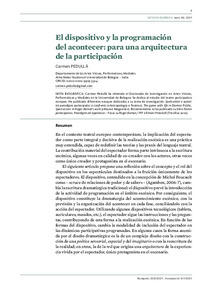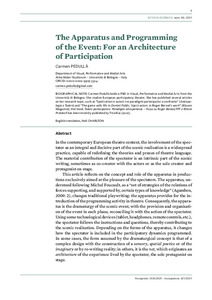Mostrar el registro sencillo del ítem
El dispositivo y la programación del acontecer: para una arquitectura de la participación
| dc.contributor.author | Pedullà, Carmen | |
| dc.contributor.author | Pedullà, Carmen | |
| dc.date.accessioned | 2022-11-30T11:04:12Z | |
| dc.date.available | 2022-11-30T11:04:12Z | |
| dc.date.issued | 2021 | |
| dc.identifier.issn | 2385-362X | |
| dc.identifier.issn | 0212-3819 | |
| dc.identifier.uri | http://hdl.handle.net/20.500.11904/1257 | |
| dc.description.abstract | <p>En el contexto teatral europeo contemporáneo, la implicación del espectador como parte integral y decisiva de la realización escénica es una pràctica muy extendida, capaz de redefinir las teorías y las praxis del lenguaje teatral. La contribución material del espectador forma parte intrínseca a la escritura escénica, algunas veces en calidad de co-creador con los actores, otras veces como único creador y protagonista en el escenario.</p> <p>El siguiente artículo propone una reflexión sobre el concepto y el rol del dispositivo en los espectáculos destinados a la fruición únicamente de los espectadores. El dispositivo, entendido en la concepción de Michel Foucault como —«cruce de relaciones de poder y de saber»— (Agamben, 2006: 7), cambia la escritura dramatúrgica tradicional: el dispositivo prevé la introducción de la actividad de programación en el ámbito escénico. Por consiguiente, el dispositivo constituye la dramaturgia del acontecimiento escénico, con la previsión y la organización del acontecer en cada fase, conciliándolo con la acción del espectador. Utilizando algunos dispositivos tecnológicos (tableta, auriculares, mandos, etc.), el espectador sigue las instrucciones y las preguntas, contribuyendo de esta forma a la realización escénica. En función de las formas del dispositivo, cambia la modalidad de inclusión del espectador en las dinámicas participativas programadas. En algunos casos la forma asumida por el diseño dramatúrgico es la de un complejo diseño con la construcción de una <em>poética sensorial</em>, <em>espacial </em>y del <em>imaginario </em>o con la reescritura de la realidad; en otros, la de la <em>red </em>que origina una <em>arquitectura </em>de la experiencia vivida por el espectador, único protagonista en el escenario.</p> <p>A partir de estas reflexiones, se examinarán diferentes paradigmas participativos, para analizar cómo estas prevén modalidades específicas de relación: entre el espectador y la performance participativa; entre los espectadores; y entre el espectador consigo mismo. De cada tipología se mostrarán ejemplos específicos, que permitirán establecer una mirada extensa a los lenguajes propios de la participación y a las mutaciones que esta implica en los códigos lingüísticos teatrales.</p> | |
| dc.description.abstract | <p>In the contemporary European theatre context, the involvement of the spectator as an integral and decisive part of the scenic realisation is a widespread practice, capable of redefining the theories and praxes of theatre language. The material contribution of the spectator is an intrinsic part of the scenic writing, sometimes as co-creator with the actors or as the sole creator and protagonist on stage.</p> <p>This article reflects on the concept and role of the apparatus in productions exclusively aimed at the pleasure of the spectators. The apparatus, understood following Michel Foucault, as a “set of strategies of the relations of forces supporting, and supported by, certain types of knowledge” (Agamben, 2009: 2), changes traditional playwriting: the apparatus provides for the introduction of the programming activity in theatre. Consequently, the apparatus is the dramaturgy of the scenic event, with the provision and organisation of the event in each phase, reconciling it with the action of the spectator. Using some technological devices (tablet, headphones, remote controls, etc.), the spectator follows the instructions and questions, thereby contributing to the scenic realisation. Depending on the forms of the apparatus, it changes how the spectator is included in the participatory dynamics programmed. In some cases, the form assumed by the dramaturgical concept is that of a complex design with the construction of a <em>sensory</em>, <em>spatial poetics </em>or of the <em>imaginary </em>or by re-writing reality; in others, it is the <em>net</em>, which originates an <em>architecture </em>of the experience lived by the spectator, the sole protagonist on stage.<strong><em> </em></strong></p> <p>Based on these reflections, we will explore different participatory paradigms in order to analyse how these provide for specific modes of relationship: between the spectator and the participatory performance; between the spectators; and between the spectator and him or herself. We will provide specific examples of each typology, which will enable us to establish a broad vision of the languages characteristic of participation and of the mutations that it involves in the theatrical linguistic codes.</p> | |
| dc.relation.ispartof | Estudis escènics: quaderns de l'Institut del Teatre. 2021, Núm. 46 | |
| dc.title | El dispositivo y la programación del acontecer: para una arquitectura de la participación | |
| dc.type | Article | |
| dc.date.updated | 2022-11-30T11:04:13Z | |
| dc.rights.access | Open Access |
Ficheros en el ítem
Este ítem aparece en la(s) siguiente(s) colección(ones)
-
2021: Núm.: 46 [21]



